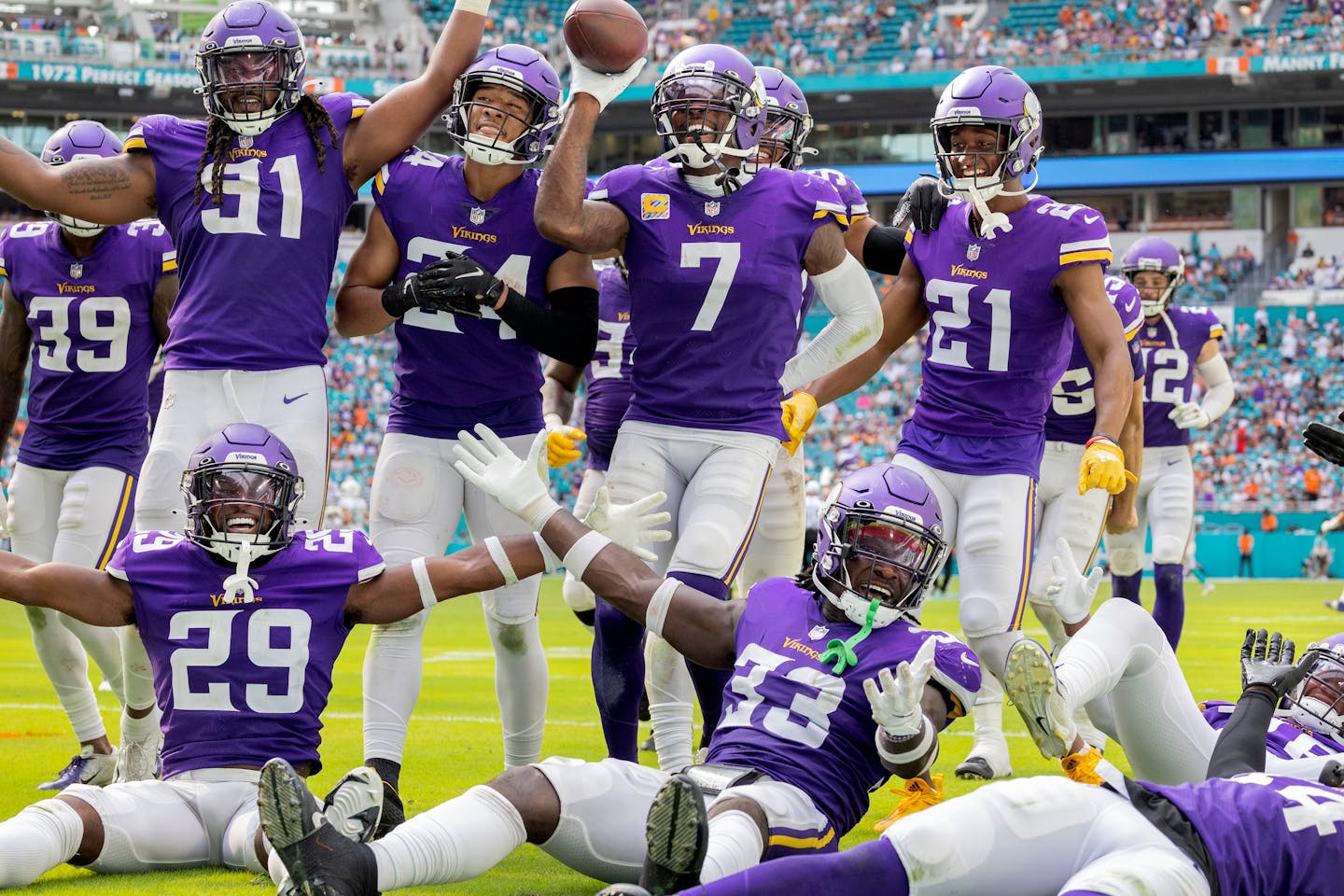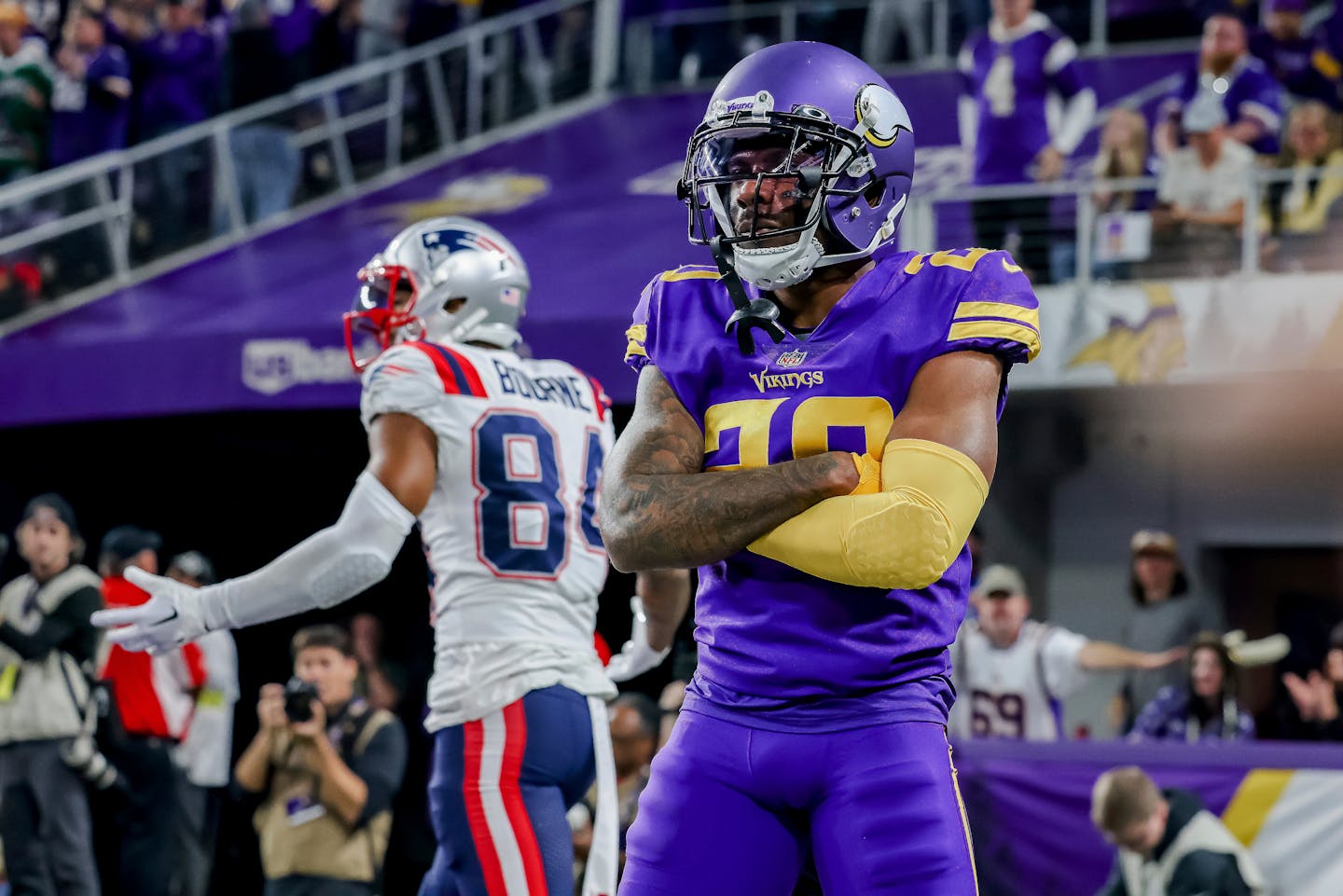Most Wednesday nights, the standing offer before the Vikings' young cornerbacks is this: Their eight-time Pro Bowler teammate will cook them dinner and tell them his secrets.
Patrick Peterson puts the call out for menu requests on Tuesdays. Cameron Dantzler, the pupil who inspired Peterson to make this a weekly ritual, is "a chicken wings guy." Peterson normally whips up a pasta dish as well. The players dine together at the 32-year-old cornerback's home, watching a quarter or two of whatever NBA game is on TV while they're eating. Then, they study film for 75 minutes.
The group reviews all of the Vikings' first- and second-down passes, talks over pre-snap alignments on the team's defensive calls and discusses how wide receiver motion might affect coverage on a given play. Over and over, the film of a given play leads them back to the same question.
"'How did you know that was coming?'" Peterson says with a laugh.
After 181 career games, he knows where to find the answers. He surveys film of opposing offenses like a forensic scientist working a crime scene for clues, spotting tells in the way a receiver is aligned or where the ball is placed on the field. Those clues are why Peterson, the fifth pick in 2011, is the only one of the 53 defensive backs in his draft class still in the NFL, in the middle of a resurgent season at a position most of his contemporaries long ago ceded to the youngsters. They are what his teammates show up for every week.
"All offenses are the same; they just dress it up different now," Peterson said. "Sixty plays in a game; you do 60 times 180, that's a lot of snaps. I've seen it so much to where it's kind of like walking to me. That's what I want to pass on to those guys."
His reasons for sharing it all, with a group of players bound to replace him sooner than later, are mostly altruistic. Peterson has told his wife, Antonique, he'll be done playing football in "three years, tops." Broadcasting, not coaching, piques his interest as a post-career path that could give him more time at home with his two daughters. The final years of his playing career, then, are the avenue for Peterson to share experience and leave the game better than he found it.
There's an implicit benefit for Peterson, particularly if a pass defense that's given up the second-most yards in the league begins to jell. Those 181 career games include just three in the postseason. This Vikings team could guarantee him a fourth one, potentially as soon as Sunday. He wants a fifth, a sixth, as many as it takes for this season to end with Peterson celebrating a Super Bowl victory at the stadium in Arizona where he played for a decade.
"I pray literally on this every day: asking the Lord to give me the strength to pass through my teammates and help them be the best they can be," he said. "And that's not me just telling them what to do. I want to lead by example, by me continuing to show them, 'All right, this dude is pouring all his energy into me — I don't want to short-hand him or myself.'"
Peterson is a trusted conduit for defensive backs coach Daronte Jones and a valuable counterpart for six-time Pro Bowl safety Harrison Smith, who prefers to let Peterson do the talking when something needs to be said. The cornerback still holds his own with special teams players in the Vikings' near-daily fastest-man competitions; he talks to young players afterward about how he's kept his body in good enough shape to beat them at age 32.
Few reach his level of NFL success. Jordan Hicks, his teammate in Arizona and Minnesota, said few are as intentional as Peterson is about sharing it.
"I think that's what makes him a favorite guy to play with, and just somebody young guys can always lean on," Hicks said. "It's invaluable. The quicker you can see those types of things and think the way a future Hall-of-Famer thinks, that's something you can't get everywhere."
'Why not show him everything he needs?'
Peterson occasionally watched film at the Vikings' facility in 2021 with Dantzler and cornerback Kris Boyd. After Dantzler gave up the game-winning touchdown to Amon-Ra St. Brown in the Vikings' loss to the winless Lions last December, he immediately texted Peterson to ask what he did wrong. Peterson, who watched the game from home while on the COVID-19 list, told Dantzler he'd played too deep in the end zone.
Their texts continued during the offseason, but their tone changed. Dantzler repeatedly told Peterson how hungry he was to take the next step.
"I'm like, 'He wants it, so why not give it to him?'" Peterson said. "Why not show him everything he needs to be successful in this league?"
Peterson's cache with young corners is unquestioned. Rookie Akayleb Evans, who'll start opposite Peterson against the Jets on Sunday, grew up with Peterson as his favorite player; Evans picked No. 21 because Peterson wore it in Arizona. When Jones was defensive coordinator at LSU, he queued up highlights of Peterson for players like first-round pick Derek Stingley to watch.
Jones mentions a few specific items for Peterson to cover in his Wednesday night sessions. Otherwise, he lets Peterson plan the evening.
"I don't have kids, but I'm sure when a parent tells a kid to do something, his peer [saying it] is going to hit home harder," Jones said. "And plus, he can give it to them from a player's perspective. He can tell them why he's able to jump certain things, and how he knows what's coming."
When players ask him how he knew what was coming on a certain play, Peterson gives them a step-by-step process he's long used to eliminate most of the guesswork.
By paying attention to where the ball is spotted, how many receivers the offense has on either side of the offensive line and how close those receivers are aligned to the formation, Peterson said, he can trim the list of possible routes his opponent could run from 10 to three or four.
If the ball's on the hash closest to him, Peterson said, and the receiver is in a tight formation, "there's only three routes he can run: an under, a speed out and a 7-cut." If the ball is on the opposite hash and the receiver is in close, "I'm thinking, 'Well, drive concept; inside-breaking routes.'
"Nine times out of 10, I have a feeling of what's coming at me. So now I'm going to play for that — unless he shows me a different [route] stem," Peterson said. "If he don't give me what I'm looking for initially, I'm saying, 'Now, I have to play to my leverage.' If I'm in a single-high [safety], I want to play outside and funnel everything back to my safety, back to the middle of the field."
The moments where he saw it click for the Vikings' other corners were some of Peterson's favorites of the year.
Against the Patriots on Thanksgiving night, Duke Shelley was, due to injuries, the fourth corner to start opposite Peterson this season. On the last play of the first half, Shelley lined up to press receiver Kendrick Bourne, having talked with Peterson about how the Patriots would check to a fade route any time they faced press coverage near the goal line. Shelley stationed himself right across from Bourne on the line of scrimmage; Bourne ran the fade route Shelley expected, and Shelley broke up the pass, forcing New England to settle for a field goal.
"It gets you more excited, because it's like, 'I can do that,'" Shelley said. "That's not the physical part of the game; that's the mental part of the game that can give you an advantage. Anybody can line up and study the game and kind of know what's going on if you're taking your craft seriously."
'I knew it was going to be special'
Presented with the idea that watching Peterson at age 32 might lead young players to think everyone can replicate him, Jones responds with a knowing laugh.
"If I'm a young guy and I see him [running fastest-man competitions], naturally, I think that I can do that," Jones said. "But that's not the case."
The Vikings' defensive scheme change this season has reduced the load on Peterson's body by less frequently asking him to press receivers and follow them across the field. Instead, he's able to play more snaps with his eyes on the quarterback and put himself in position to break up or intercept passes.
"I think it's definitely something that can make my career that much longer," he said.
Through 11 games, he's posted more pass breakups (12) than in any season since 2013 and his three interceptions are his most since 2012. He will again be a free agent after the season, though he's said he wants to finish his career in Minnesota. After his first few days with new coach Kevin O'Connell, Peterson knew he could be in for a memorable season.
"Knowing the players — just the players alone — that we had coming back, I knew it was going to be special," he said. "We just needed the right guy to lead us. That was it."
O'Connell called Peterson "one of those gold-standard type of captains we have that doesn't get talked about a lot. You can't talk about his impact on our team without talking about that first."
Evans once called Peterson his favorite player. Now, he calls him a mentor, too.
"Sometimes, I feel like guys would be almost afraid to ask certain questions, especially when it's somebody you looked up to," Evans said. "But the first day I met him, when I told him I wanted to learn from him, he was very open with me. He's been a huge resource."



